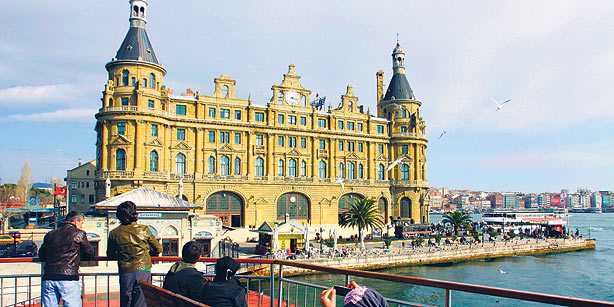
İstanbul’s century-old Haydarpaşa Railway Station was built during the reign of Sultan Abdülhamit II, in 1908. (PHOTO SUNDAY’S ZAMAN, M. FETHULLAH AKPINAR)
Many of these are still in use in Turkey today and their stories have recently been compiled into a fascinating book by a university lecturer. A thick, hardcover volume written by Yıldız Technical University lecturer Fatmagül Demirel, “Sultan II Abdülhamid’in Mirası — İstanbul’da Kamu Binaları” (Sultan Abdülhamit II’s Heritage — Public Buildings in İstanbul) illuminates the construction history and present condition of 13 public buildings built in the time of Sultan Abdülhamit II.
The book, which was printed and financed by the İstanbul Chamber of Commerce (İTO), has high quality gilded pages. It includes the following buildings: the School of Fine Arts (Sanayi-i Nefise), Sirkeci Train Station, the Royal Museum (Müze-i Hümayun), the Halkalı School of Agriculture, the Ziraat Bank building, the Almshouse (Darülaceze), the Ottoman Public Debt Administration Building (Düyun-ı Umumiye Binası), the Abdülhamit Children’s Hospital (Hamidiye Etfal Hastanesi), the Ministry of Forestry, the Mining and Agriculture Building, (Orman Ma’adin ve Ziraat Nezareti), the first Ottoman school of medicine (Mekteb-I Tıbbiye-i Şahane), the Ministry of Property Records (Defter-i Hakani Nezareti), the Telegraph and Post Ministry and Haydarpaşa Train Station.
The book, as visually rich as it is informative, was published to showcase an era when Ottomans showed great interest in establishing new institutions and building strong and magnificent buildings for these institutions.
Demirel explains in the book’s introduction, “In the changing face of 19th century İstanbul, instead of seeing huge monumental mosques, İstanbul lent itself to new buildings like military barracks, new palaces near the Bosporus, new school buildings, clock towers and new administrative buildings. Thus we can say that, after the reforms, the winds of change also affected the buildings.”
Darülaceze — which derives from the Arabic words “dar,” meaning home, and “aceze,” meaning weak or incapable — is a homeless shelter for those without families, built by Sultan Abdülhamit II when the number of beggars in İstanbul increased enormously, most of whom were not disabled or orphaned, but simply preferred not to work.
The historic Darülaceze comprised 18 smaller buildings, including rooms for the staff, four buildings for Muslims and four buildings for Christians. Under the dormitories, the buildings had dining halls and workshops where various goods were produced. The Muslim and Christian buildings both had public baths and two-story hospitals. Muslims were given a mosque and Christians were given two churches: one for Armenians and another for Greeks. Official records show that, after opening in 1896, Darülaceze hosted 9,394 people until 1909. In 1909 a total of 1,002 people were living in Darülaceze, including one Bulgarian, 50 Jews, four Armenian Catholics, 63 Armenians, 122 Greek Orthodox and 762 Muslims.
Hamidiye Etfal Hastanesi was the first children’s hospital in Ottoman history and it now serves as a public hospital, called the Şişli Etfal Hospital. Sultan Abdülhamit II’s daughter, Ayşe Osmanoğlu, stated that her father decided to build a children’s hospital after his other daughter, Ulviye Sultan, died in a fire. Demirel quotes Osmanoğlu’s words in the book, in which Osmanoğlu reads her father’s words about the fire incident, “My daughter could not survive. I wonder how poor people’s children are growing up in hardship. I shall at least build a hospital to prevent other fathers from grieving in pain like me.”
Furthermore, Demirel states that many of the Ottoman buildings that are now in use were built in the Sultan Abdülhamit II era. She adds that world-renowned architects built most of these buildings, including French-Ottoman architect Levanten Alexandre Vallaury, who taught architecture for 25 years in the School of Fine Arts; and Italian Raimonda D’Anarco, who built the Ottoman Bank building, the Pera Palace Hotel, the Tokatlıyan Hotel and the Ottoman Public Debt Administration Building.
German architects also built many historic buildings in İstanbul, including A. Jashmund, Otto Ritter, Helmuth Cuno and Otto Kapp.
Jashmund built the well-known Sirkeci Train Station, which was called “Osmanlı toplumu için batıya açılan kapı” (the door that opens to the West for Ottoman society). It was built on the historical peninsula on the European side of İstanbul in January 1871. It was not a coincidence for the Ottoman administration to build its first railway routes in the European part of the state. In fact, Ottomans intended to quickly transport their army with trains, when there was a need to suppress a possible rebellion.
Turkey’s famous Haydarpaşa Railway Station, which is still in use, was built by German architects Ritter and Cuno. But Turkey’s busiest rail terminal is now taking a break in service for the first time since the station’s main building opened in 1908. Service has been interrupted so that improvements on the high-speed train (YHT) line to Ankara and the Marmaray project, which will connect İstanbul’s Asian and European sides via an undersea commuter train line, can be completed. The decision has sparked anger and frustration among people of all generations, many of whom see the move as typical of a trend pushing urban renewal in İstanbul to the detriment of preserving historic structures.
The book contains detailed information history of many buildings, with hundreds of new and old photographs. The İTO stated that it plans to distribute the book all around Turkey soon.

Leave a Reply